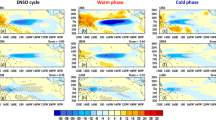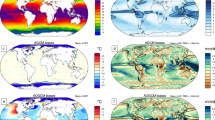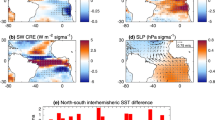Abstract
We examine the diurnal cycle of marine cloud feedback using high frequency outputs in CFMIP-2 idealised uniform +4 K SST perturbation experiments from seven CMIP5 models. Most of the inter-model spread in the diurnal mean marine shortwave cloud feedback can be explained by low cloud responses, although these do not explain the model responses at the neutral/weakly negative end of the feedback range, where changes in mid and high level cloud properties are more important. All of the models show reductions in marine low cloud fraction in the warmer climate, and these are in almost all cases largest in the mornings when more cloud is present in the control simulations. This results in shortwave cloud feedbacks being slightly stronger and having the largest inter-model spread at this time of day. The diurnal amplitudes of the responses of marine cloud properties to the warming climate are however small compared to the inter-model differences in their diurnally meaned responses. This indicates that the diurnal cycle of cloud feedback is not strongly relevant to understanding inter-model spread in overall cloud feedback and climate sensitivity. A number of unusual behaviours in individual models are highlighted for future investigation.







Similar content being viewed by others
References
Andrews T, Forster PM (2008) CO2 forcing induces semi-direct effects with consequences for climate feedback interpretations. Geophys Res Lett 35:L04802. doi:10.1029/2007GL032273
Andrews T, Gregory JM, Webb MJ, Taylor KE (2012) Forcing, feedbacks and climate sensitivity in CMIP5 coupled atmosphere-ocean climate models. Geophys Res Lett 39:L09712. doi:10.1029/2012GL051607
Bentsen M, Bethke I, Debernard JB, Iversen T, Kirkevag A, Seland O, Drange H, Roelandt C, Seierstad IA, Hoose C, Kristjansson JE (2012) The Norwegian earth system model, NorESM1-M—Part 1: description and basic evaluation. Geosci Model Dev Discuss 5:2843–2931. doi:10.5194/gmdd-5-2843-2012
Bony S, Emanuel KS (2001) A parameterization of the cloudiness associated with cumulus convection; evaluation using TOGA COARE data. J Atmos Sci 58:3158–3183. doi:10.1175/1520-0469(2001)58<3158:APOTCA>2.0.CO;2
Bony S et al (2011) CFMIP: towards a better evaluation and understanding of clouds and cloud feedbacks in CMIP5 models. Clivar Exchanges 56(16):2
Bouniol D, Couvreux F, Kamsu-Tamo P-H, Leplay M, Guichard F, Favot F, O’Connor E (2012) Diurnal and seasonal cycles of cloud occurrences, types and radiative impact over West Africa. J Appl Meteor Climatol 51:534–553. doi:10.1175/JAMC-D-11-051.1
Bretherton CS (2006) The climate process team on low-latitude cloud feedbacks on climate sensitivity. US Clivar Variations 4:7–12
Dufresne J-L, Bony S (2008) An assessment of the primary sources of spread of global warming estimates from coupled atmosphere-ocean models. J Climate 21:5135–5144
Duynkerke PG, de Roode SR, van Zanten MC, Calvo J, Cuxart J, Cheinet S, Chlond A, Grenier H, Jonker PJ, Kohler M, Lenderink G, Lewellen D, Lappen C-L, Lock AP, Moeng C-H, Muller F, Olmeda D, Piriou J-M, Sanchez E, Sednev I (2004) Observations and numerical simulations of the diurnal cycle of the EUROCS stratocumulus case. QJR Meteorol Soc 130:3269–3296. doi:10.1256/qj.03.139
Gregory JM, Webb MJ (2008) Tropospheric adjustment induces a cloud component in CO2 forcing. J Climate 21:58–71. doi:10.1175/2007JCLI1834.1
Hazeleger W, et al. (2012) EC-Earth V2.2: description and validation of a new seamless earth system prediction model. Clim Dyn. doi:10.1007/s00382-011-1228-5ed
Hazeleger W et al (2010) EC-Earth: a seamless earth-system prediction approach in action. Bull Am Meteorol Soc 91:1357–1363. doi:10.1175/2010BAMS2877.1
He J, Soden BJ, Kirtman B (2014) The robustness of the atmospheric circulation and precipitation response to future anthropogenic surface warming. Geophys Res Lett 41:2614–2622. doi:10.1002/2014GL059435
Held IM, Soden BJ (2006) Robust responses of the hydrological cycle to global warming. J Climate 19:5686–5699. doi:10.1175/JCLI3990.1
Hourdin F et al (2012) Impact of the LMDZ atmospheric grid configuration on the climate and sensitivity of the IPSL-CM5A coupled model. Clim Dyn. doi:10.1007/s00382-012-1411-3
Jiang JH et al (2012) Evaluation of cloud and water vapour simulations in CMIP5 climate models using NASA “A-Train” satellite observations. J Geophys Res 117:D14105. doi:10.1029/2011JD017237
Kawai H, Inoue Y (2006) A simple parameterization scheme for subtropical marine stratocumulus. SOLA 2:17–20
Klein SA, Jakob C (1999) Validation and sensitivities of frontal clouds simulated by the ECMWF model. Mon Weather Rev 127:2514–2531
Lacagnina C, Selten FM (2014) Evaluation of clouds and radiative fluxes in the EC-Earth general circulation model using the ISCCP simulator. Clin Dyn. doi:10.1007/s00382-014-2093-9
Li J, Curry CL, Sun Z, Zhang F (2010) Overlap of solar and infrared spectra and the shortwave radiative effect of methane. J Atmos Sci 67:2372–2389
Lin PF, Yu YQ, Liu HL (2013) Oceanic climatology in the coupled model FGOALS-g2: improvements and biases. Adv Atmos Sci 30(3):819–840. doi:10.1007/s00376-012-2137-1
Mapes BE, Bacmeister J, Khairoutdinov M, Hannay C, Zhao M (2009) Virtual field campaigns on deep tropical convection in climate models. J Climate 22:244–257. doi:10.1175/2008JCLI2203.1
Martin GM et al (2011) The HadGEM2 family of met office unified model climate configurations. Geosci Model Devel 4:723–757. doi:10.5194/gmd-4-723-2011
O’Dell C, Wentz FJ, Bennartz R (2008) Cloud liquid water path from satellite-based passive microwave observations: a new climatology over the global oceans. J Climate 21:1721–1739. doi:10.1175/2007JCLI1958.1
Randall DA, Dazlich DA (1991) Diurnal variability of the hydrologic cycle in a general circulation model. J Atmos Sci 48:40–62
Randall DA, Wood RA, Bony S, Colman R, Fichefet T, Fyfe J, Kattsov V, Pitman A, Shukla J, Srinivasan J, Stouffer RJ, Sumi A, Taylor KE (2007) Climate models and their evaluation. In: Solomon S, Qin D, Manning M, Chen Z, Marquis MC, Avery KB, Tignor M, Miller HL (eds) Climate change 2007: the physical science basis. Contribution of Working Group I to the fourth assessment report of the intergovernmental panel on climate change. Cambridge University Press, pp 589–662
Ringer MA, McAvaney BJ, Andronova N, Buja LE, Esch M, Ingram WJ, Li B, Quaas J, Roeckner E, Senior CA, Soden BJ, Volodin EM, Webb MJ, Williams KD (2006) Global mean cloud feedbacks in idealized climate change experiments. Geophys Res Lett 33:7
Roehrig R, Bouniol D, Guichard F, Hourdin F, Redelsperger J (2013) The present and future of the West African monsoon: a process-oriented assessment of CMIP5 simulations along the AMMA transect. J Climate 26:6471–6505. doi:10.1175/JCLI-D-12-00505.1
Rossow WB, Schiffer RA (1999) Advances in understanding clouds from ISCCP. Bull Am Meteorol Soc 80:2261–2287
Seethala C, Horvath A (2010) Global assessment of AMSR-E and MODIS cloud liquid water path retrievals in warm oceanic clouds. J Geophys Res 115:D13202. doi:10.1029/2009JD012662
Soden BJ, Broccoli AJ, Hemler RS (2004) On the use of cloud forcing to estimate cloud feedback. J Climate 17:3661–3665
Stevens B, Giorgetta M, Esch M, Mauritsen T, Crueger T, Rast S et al. (2013) Atmospheric component of the MPI-M earth system model: ECHAM6. J Adv Model Earth Syst
Taylor KE, Stouffer RJ, Meehl GA (2011) An overview of CMIP5 and the experiment design. Amer. Meteor. Soc, Bull. doi:10.1175/BAMS-D-11-00094.1
Teixeira J et al (2011) Tropical and subtropical cloud transitions in weather and climate prediction models: the GCSS/WGNE Pacific cross-section intercomparison (GPCI). J Climate 24:5223–5256. doi:10.1175/2011JCLI3672.1
Vial J, Dufresne J-L, Bony S (2013) On the interpretation of inter-model spread in CMIP5 climate sensitivity estimates. Clim Dyn Doi:10.1007/s00382-013-1725-9
Voldoire A, et al (2012) The CNRM-CM5.1 global climate model: description and basic evaluation. Clim Dyn. doi:10.1007/s00382-011-1259-y
von Salzen K, Scinocca JF, McFarlane NA, Li J, Cole JNS, Plummer D, Verseghy D, Reader MC, Ma X, Lazare M, Solheim L (2013) The Canadian fourth generation atmospheric global climate model (CanAM4) Part I: representation of physical processes. Atmos-Ocean 51:104–125
Watanabe M et al (2010) Improved climate simulation by MIROC5: mean states, variability, and climate sensitivity. J Climate 23:6312–6335. doi:10.1175/2010JCLI3679.1
Webb M, Senior C, Bony S, Morcrette JJ (2001) Combining ERBE and ISCCP data to assess clouds in the Hadley Centre, ECMWF and LMD atmospheric climate models. Clim Dyn 17:905–922
Webb MJ, Lambert FH, Gregory JM (2013) Origins of differences in climate sensitivity, forcing and feedback in climate models. Clim Dyn 40:677–707. doi:10.1007/s00382-012-1336-x
Wood R, Bretherton CS, Hartmann DL (2002) Diurnal cycle of liquid cloud water path over the subtropical and tropical oceans. Geophys Res Lett 29:2092–2095
Wu T et al (2010) The Beijing Climate Center atmospheric general circulation model: description and its performance for the present-day climate. Clim Dyn 34(1):123–147. doi:10.1007/s00382-008-0487-2
Yukimoto S, et al (2011) Meteorological research institute-earth system model version 1 (MRI-ESM1) model description. Tech. Rep. 64, Meteorological Research Institute, Japan
Zelinka MD, Hartmann DL (2010) Why is longwave cloud feedback positive? J Geophys Res Atmos 115:2156–2202. doi:10.1029/2010JD013817
Zelinka MD, Klein SA, Taylor KE, Andrews T, Webb MJ, Gregory JM, Forster PM (2013) Contributions of different cloud types to feedbacks and rapid adjustments in CMIP5. J Climate. doi:10.1175/JCLI-D-12-00555.1
Zhang M, Bretherton CS (2008) Mechanisms of low cloud climate feedback in idealized single-column simulations with the community atmospheric model (CAM3). J Climate 21:4859–4878. doi:10.1175/2008JCLI2237.1
Zhang Y, Stevens B, Ghil M (2005) On the diurnal cycle and susceptibility to aerosol concentration in a stratocumulus-topped mixed layer. Quarterly Journal of the Royal Meteorological Society 131(608):1567–1583. doi:10.1256/qj.04.103
Zhang M, Bretherton CS, Blossey PN, Bony S, Brient F, Golaz J-C (2013) The CGILS experimental design to investigate low cloud feedbacks in general circulation models by using single-column and large-eddy simulation models. J Adv Model Earth Syst. doi:10.1029/2012MS000182
Acknowledgments
We would like to thank Knut von Salzen and William Ingram for helpful comments on the manuscript, and Mark Ringer and Tim Andrews for useful discussions. This work was supported by the Joint DECC/Defra Met Office Hadley Centre Climate Programme (GA01101). The research leading to these results has received funding from the European Union, Seventh Framework Programme (FP7/2007–2013) under grant agreement number 244067 via the EU Cloud Intercomparison and Process Study Evaluation project (EUCLIPSE). We acknowledge the World Climate Research Programme’s Working Group on Coupled Modelling, which is responsible for CMIP, and we thank the climate modelling groups for producing and making available their model output. For CMIP the U.S. Department of Energy’s Program for Climate Model Diagnosis and Intercomparison provides coordinating support and led development of software infrastructure in partnership with the Global Organization for Earth System Science Portals. We would like to acknowledge in particular Philip Bentley, Alejandro Bodas-Salcedo, Sandrine Bony, Jason Cole, Herve Douville, Jean-Louis Dufresne, Hideaki Kawai, Jamie Kettleborough, Tsuyoshi Koshiro, Carlo Lacagnina, Marc Salzmann, Frank Selten, Yoko Tsushima, Sophie Tyteca, and Jonny Williams for their efforts in preparing cfSites outputs from the models.
Author information
Authors and Affiliations
Corresponding author
Rights and permissions
About this article
Cite this article
Webb, M.J., Lock, A.P., Bodas-Salcedo, A. et al. The diurnal cycle of marine cloud feedback in climate models. Clim Dyn 44, 1419–1436 (2015). https://doi.org/10.1007/s00382-014-2234-1
Received:
Accepted:
Published:
Issue Date:
DOI: https://doi.org/10.1007/s00382-014-2234-1




